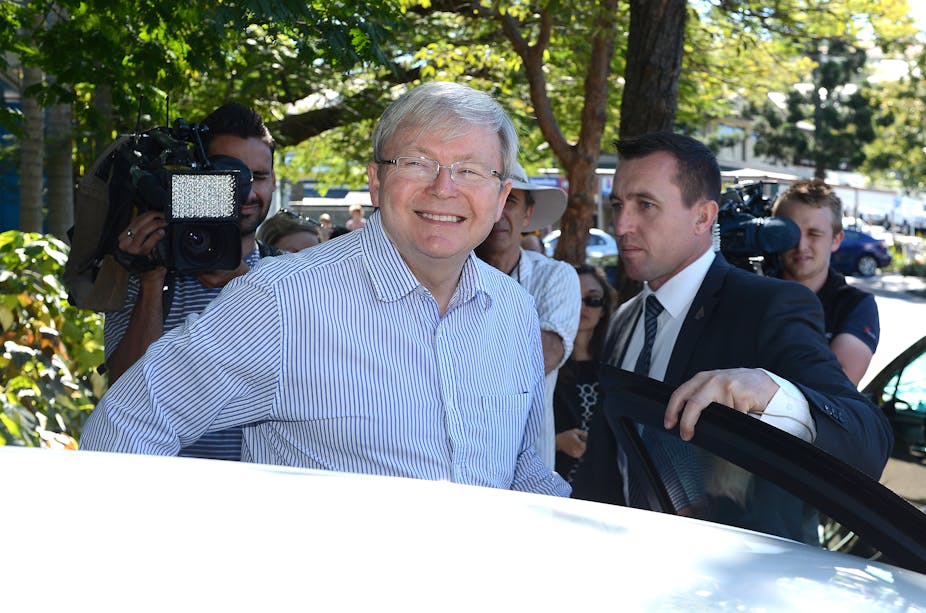If the polls are accurate and Labor is almost at level pegging with the Coalition, it would seem we are in for a repeat of the very close election of 2010. But for various reasons this is not necessarily the case.
Effectively Labor starts two seats down, as the two retiring independents from country NSW (Rob Oakeshott and Tony Windsor) will almost certainly be replaced by National Party members. Peter Slipper’s seat of Fisher will also revert to the Liberal-National Party, but he only became an independent when offered the poisoned chalice of the speakership.
But because we vote for 150 individual seats rather than holding a national ballot on proportional lines - as do some European countries - it is possible for one party to actually poll more votes and not win government, which was Labor’s fate under Kim Beazley in 1998. For Labor to win office they will need to either lose no seats they currently hold and add two, with the complication that Bob Katter - who will most likely be returned as the member for Kennedy - might back a Rudd government.
I assume, by the way, that if Greens MP Adam Bandt holds Melbourne - which might just be possible because of disgust at the PNG asylum seeker solution in the inner city seat - and Andrew Wilkie holds Denison in Tasmania (which seems likely) they would again back a Labor government, though Wilkie is more problematic.
Based on the last election, there are currently 56 marginal seats (under a margin of 6%), roughly evenly divided between the two major parties. This includes Craig Thompson’s seat of Dobell, even though the Labor Party have replaced him as a candidate.
Of these seats the majority are in Queensland and NSW, which makes the decision of both parties to run their campaigns out of Melbourne rather odd.
But one can make several predictions that will almost certainly be accurate. Some seats which seem far less marginal will change hands, and swings will not be even across states. Labor is banking on the Rudd factor to balance losses in NSW by winning back a swag of seats in Queensland, and therefore making victory possible.
On the face of it this is not unreasonable: Labor lost seven seats in Queensland in 2010. But this time they also could lose the slightly safer seat of Capricornia, based on Rockhampton, where the local member (Kirsten Livermore) is retiring. The tsunami of Labor seats in western Sydney that was feared will probably be averted, but there are two or three seats where they are unlikely to hang on.
But let’s assume Rudd can balance losses and gains in these two states, and the status quo remains in Western Australia, where Labor only holds three seats and South Australia, where they might even pick up one. Ironically, Rudd’s greatest problem may lie in the two states where Gillard did best: Victoria and Tasmania.
Current polls suggest that Labor could lose three of its four Tasmanian seats, even though they are held by reasonably comfortable margins. There are a further three seats in Victoria at risk, with no realistic hope of winning the seemingly marginal Liberal seats in that state.
The most marginal seat in Australia is the Victorian electorate of Corangamite, but it is also a model of why one has to be very careful in extrapolating from results from three years ago. Once a safe conservative seat, Corangamite stretches inland and down the coast from Geelong, and is where the television series SeaChange was set. Increasingly, it is home for retirees from Melbourne - not surprisingly, the Green vote there is higher than the state average.
Over three years its population will have changed considerably, with growth both in seaside resorts and outer suburban Geelong. The point is, it is a very different seat to marginal Deakin, in the outer (but not outermost) suburban ring of Melbourne, 100 kilometres away. The demographic particularities of each seat helps explain why every close election produces very different swings, even within the same state.
When Rudd campaigned in 2007 he surprised political journalists by making forays into what seemed safe Liberal territory - and won several Queensland seats that were listed as safe on most lists.
In the end, Labor lost one seat in Western Australia, but picked up almost everywhere else. Even Rudd himself cannot expect to repeat that feat this time around.

